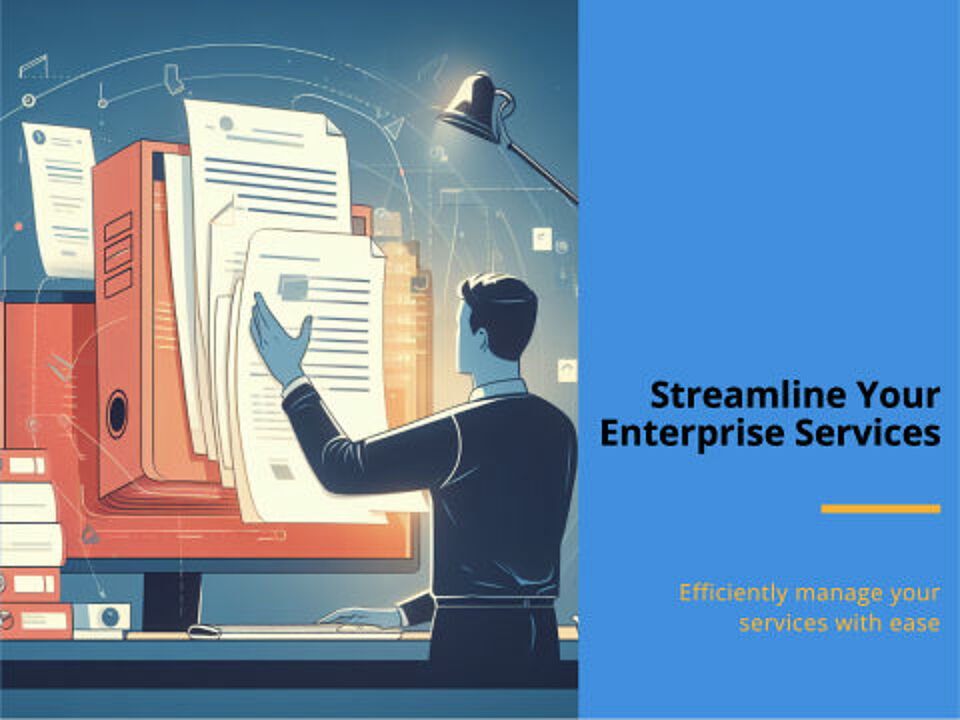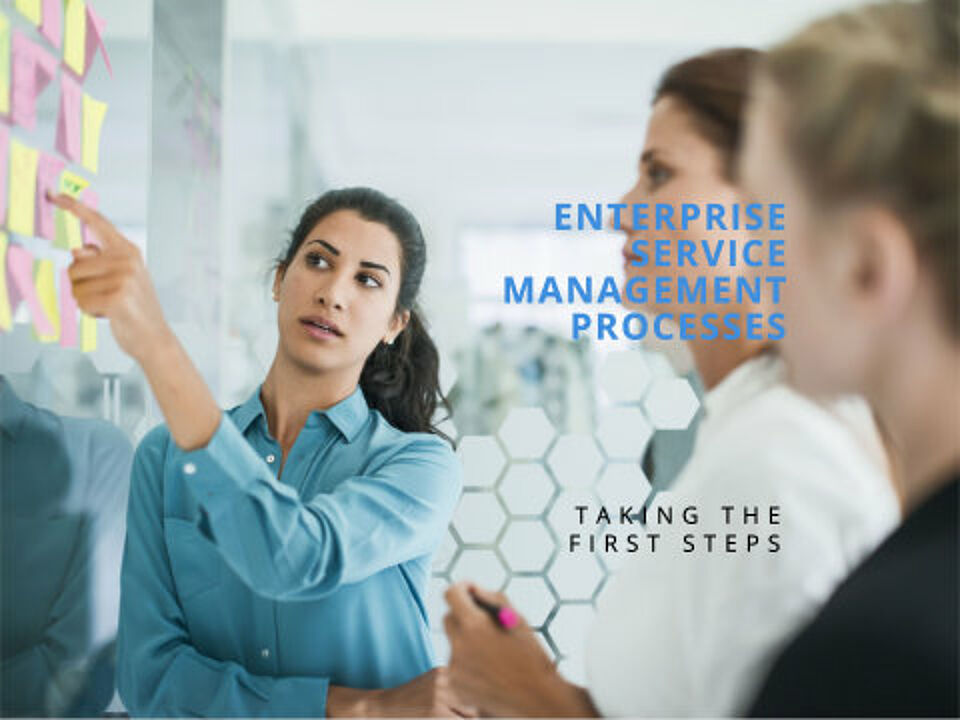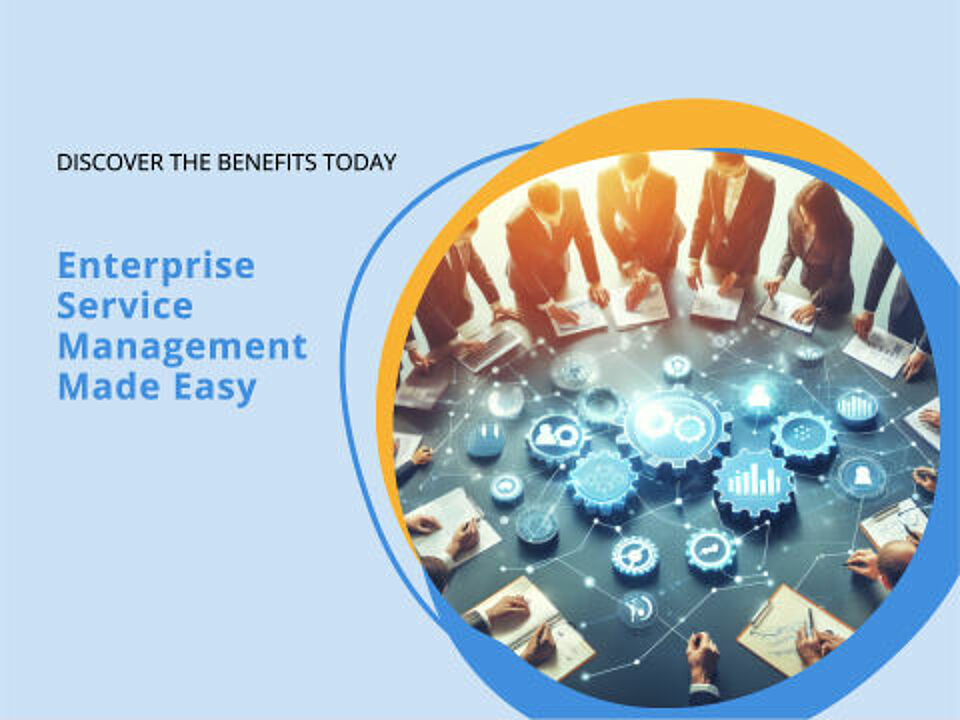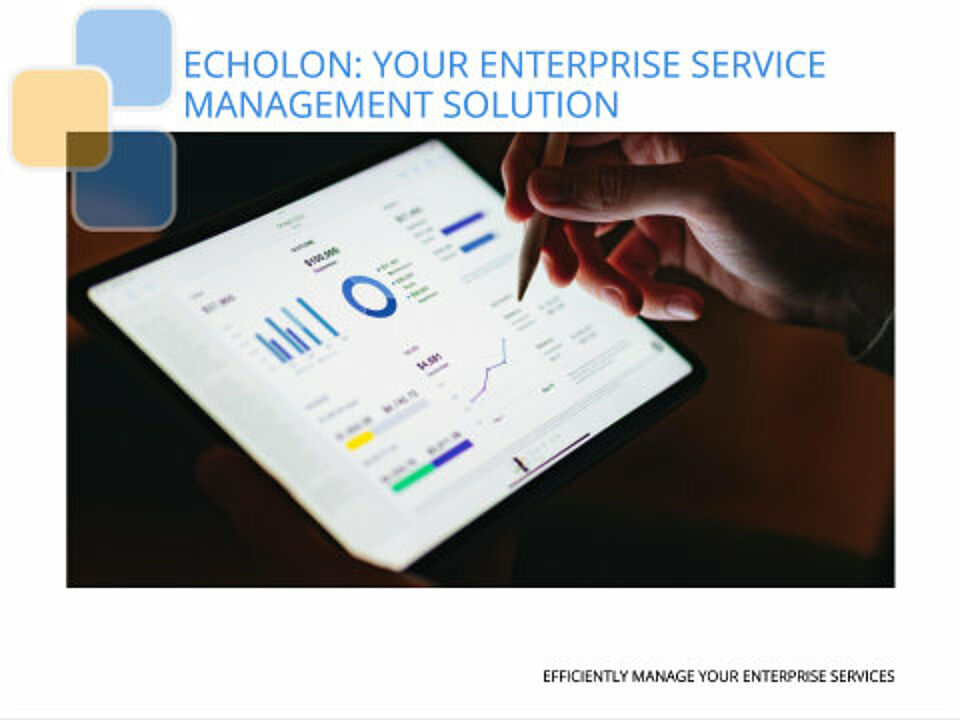
What is Enterprise Service Management? - Origin
ESM is an acronym for Enterprise Service Management. It is a comprehensive approach to managing the entire organisation based on the provision of services. ESM also encompasses all processes of IT Service Management (ITSM), Customer Service Management (CSM), Project and Portfolio Management (PPM), Human Resources (HR) and Facility Management (FM) across the organisation. Best practices and the idea of Enterprise Service is to unite all service desks in the company and standardise processes and services.
It offers a standardised view of all business processes across the entire company. Departments and the specialist area manage their service design independently and also in a centralised manner. ESM is usually implemented as a software solution that also serves all ITSM processes of the IT department. ESM can help to improve the efficiency and effectiveness of service delivery within an organisation. It also ensures that services are provided in a standardised and controlled manner.
What sounds simple at first is anything but trivial to implement. ESM is based on the idea of controlling all of these services via a single management tool. The implementation and digitalisation of the various specialist areas requires a lot of effort, but it is worth it. More than half of all German companies are aware of the benefits of a functioning ESM and are therefore planning to introduce it in the coming years. But how did Enterprise Service Management actually come about and how exactly does it work?

How was the ESM created and how does it work?
Originally, service management was mainly used in IT. IT Service Management (ITSM) involved the central organisation of processes and thus ensured greater use of resources. Using a catalogue of requirements, the IT Infrastructure Library (ITIL), ITSM has been adapted and expanded across all sectors over the years, making it increasingly effective. Over time, the question arose as to why only processes in IT should be standardised. Why couldn't other areas of the company also benefit from the advantages of process optimisation? This gave rise to the idea of Enterprise Service Management.
The idea and functionality of ESM are defined by the service lifecycle. This comprises five phases:
- The service strategy: In the first phase, the strategy with which the service is to be implemented is determined. Factors to be considered are customer needs, the company's strengths and weaknesses and the technical setup.
- The service design: In the second step, the results of the service management are considered, as well as how the service offering can be implemented.
- Service creation / service transition: The next step is to implement what has been decided so far. The suitable technical infrastructure is selected and the services are digitalised.
- Service operation: In the fourth phase, the services are put into operation and extensively tested in the process. Do they meet expectations, are they effective and efficient? And most importantly, do they provide customers with the desired added value?
- Service improvement: In the fifth and final step, continuous improvement is ensured. Previously identified shortcomings are addressed and worked on.

ITSM and Enterprise Service Management
Enterprise service management is an integrated and coordinated set of processes and services that support the entire life cycle of an organisation's products and services. The IT service management processes according to the IT Infrastructure Library (e.g. ITIL 4) form a framework for the management of IT services or IT service processes. The processes cover the planning, provision and control of IT services and extend over their entire life cycle. Services are provided by internal and external service providers as well as specific service providers.
The most important ITSM processes are
Service Operation (SO)
Is one of the core components of the ITIL framework. SO is responsible for the availability and support of services to customers. The main objective of Service Operation is to ensure that services are delivered in a consistent and reliable manner. Service Operation also ensures that service disruptions are minimised and service levels are met.
Service Strategy (SS)
Service Strategy is a framework for best practices in service management. It provides guidance for the design, implementation and improvement of service management processes. The aim of Service Strategy is to align business and IT services with the needs of the organisation. It contains guidance on service portfolio management, service level management, demand management and financial management.
Service Design (SD)
Includes the provision of IT services based on the level of quality expected by the customer and the resource capacities of the organisation. SD also includes product development. The service product is designed and developed in collaboration with the relevant stakeholders. As a high degree of creativity is required when designing the services, there are various methods for this, such as the brainstorming method, the organisation of workshops or the use of creativity techniques.
The service design is then implemented through comprehensive planning of the service processes. Numerous tools and methods are available for this. Further information can be found in the blog article: Service design instead of chance - basics and application.

ESM first steps - processes
The first step in introducing an ESM tool is to identify the requirements that are central to your employees' workflows.
You should then consider which type of ESM tool is best suited to your organisation. There are different types of ESM tools, and each has its own advantages and disadvantages. You also need to decide whether you want to use an ESM tool as a cloud service or local software. Choosing the right infrastructure is also important. Most ESM vendors offer a free presentation and preliminary consultation.
Further questions:
- Does a new service strategy need to be developed?
- Are there existing tools in-house?
- Can these be expanded or does it have to be new software?
The next step in introducing an ESM is to draw up a project plan for implementing the system. This plan describes in detail how the system will be installed and configured. It should also identify the relevant processes, workflows and automations ( ITSM and ESM ) that are central to your employees' workflows. Once you have identified these, you can start deploying the ESM tool and the knowledge base. The aim is to make these services available to employees as quickly and easily as possible so that they can use them immediately.
ESM solution in personnel administration (HR)
Enterprise Service Management in HR can help to streamline business processes and improve process automation, as many standard workflows can be fully automated. By using an ESM platform, HR can set up a self-service portal through which employees can access, submit requests, access information and track the status of their requests. Many organisations hire new employees quickly and efficiently through 'employee onboarding'. This can help to reduce the workload of HR staff through digital transformation. This creates added value that improves the efficiency of the department. In addition, service management can help to recognise bottlenecks in business processes and make suggestions for improvement.
ESM solution in the finance and legal department
As described above, enterprise service management is a holistic approach to managing an organisation's entire range of services, from back-office functions to customer-facing front-line functions. In the legal department, ESM can also help to automate and streamline processes, improve communication and collaboration, and ultimately deliver better services to clients.
In the finance department, ESM can help to increase the efficiency of accounting processes. By automating recurring tasks and implementing self-service portals for employees, customers and suppliers, costs can be reduced and errors minimised.
It can also help improve compliance with regulatory requirements by providing a centralised platform for managing policies, approval processes and audits.
By implementing an ESM solution, the finance and legal departments can collaborate more efficiently both internally and externally, ultimately improving operational efficiency and increasing customer satisfaction.
ESM solution in facility management
Facility management (FM) is the coordination of the physical workplace with the people and work of an organisation. It integrates the principles of business management, architecture and technology. The aim of facility management is to ensure that the organisation's operational processes run smoothly. This includes, among other things, the flawless availability of rooms, facilities and technical equipment as well as the organisation of communication and technology. It is based on best practices from various industries.
ESM can help FM organisations to manage their facilities and services more effectively. ESM solution provides a structured approach to the planning, design, implementation and management of facility-related activities. It can help FM organisations to maintain operations, improve service quality and customer satisfaction while reducing costs.
Conclusion
ESM is a powerful tool that can help more than just large organisations to streamline their service processes, reduce costs and increase customer and employee satisfaction. By breaking down the silos between different service areas and bringing them together into a unified system, organisations can significantly increase their efficiency, productivity and service quality.
Whether you want to optimise your ITSM processes in the IT organisation, streamline your facility management or better engage your employees, EcholoN's end-to-end service management software provides the tools and features you need to succeed.

The advantages of Enterprise Service Management at a glance
The introduction of ESM can bring a variety of benefits to organisations of all sizes. Some of the key benefits include:
- Improved service quality: by streamlining and standardising service management processes, organisations can provide a more consistent and higher quality service to their customers and employees.
- Increased efficiency: Enterprise Service Management reduces duplication of effort, eliminates manual tasks and automates routine tasks, resulting in measurable increases in efficiency and productivity.
- Cost reduction: The automation and optimisation of service management processes can lead to significant cost savings for companies, both in terms of employee time and resources.
- Increased customer satisfaction: By improving service quality and response times, organisations can increase customer satisfaction and loyalty.
- Better decision-making: Enterprise Service Management provides companies with real-time data and analyses that they can use to make informed decisions and continuously improve their service offering.

What does EcholoN offer as an ESM solution?
Bill Gates put it aptly some time ago:
"The first rule of any business technology is that automating an efficient operation will strengthen efficiency. The second rule is that automating an inefficient operation will increase inefficiency."
EcholoN Enterprise Service Management is based on the holistic EcholoN Enterprise Framework with an integrated, AI-supported workflow engine and an agile, process-orientated way of working. Standard process templates ( ITIL v3 / 4, QAF, CAFM, CRM etc. ) as the basis of the EcholoN framework support all digitalisation use cases. They can be customised and updated.
EcholoN holistic service management offers a wide range of functions and options as an ESM solution, including
- Ticket system, service desk, knowledge base: The ability to record and manage service requests, solve problems and improve customer service.
- IT Service Management: The management of IT services, including incident and problem management, change and release management and configuration management.
- Customer service management: Customer support - CSM as an effective and strategic method for increasing customer satisfaction and customer loyalty
- Facility Management: The management of property, facilities and resources, including maintenance, repairs and security.
- Human Resources Management: The management of employees, their duties, training and benefits.
- Contract Management: The management of agreements, contracts and service level agreements.
- Enterprise Asset Management: The management of assets, equipment and inventory.
- Reporting and analysis: The ability to collect, analyse and visualise data to gain insight into service performance and make informed decisions.
- Integration options via ETL: Seamless integration with other company applications and systems to ensure efficient data exchange.
EcholoN therefore offers a comprehensive and adaptable ESM solution that helps companies to optimise their service processes, increase efficiency and ensure high service quality.
EcholoN - A tool at the centre of your services
EcholoN ESM is based on the powerful EcholoN framework that helps you manage your product portfolio (service catalogue) and track feedback from employees and customers, suppliers and partners. It gives you the ability to customise your services to the specific needs of your customers and provides you with the insights you need to continuously improve your offering. Automated workflows, company-wide and clearly defined process flows and services. With EcholoN, you can be sure that your services and products are always at the centre of the customer experience. EcholoN helps companies to increase employee satisfaction. You achieve continuous improvement in all areas of your organisation.
Conclusion
If companies decide to learn from the experiences of IT service management and digitise and standardise all specialist areas in the company, ITSM becomes ESM. This brings with it a high degree of efficiency, convenience and quality, provided it is implemented correctly and a suitable software solution is used.
Customer satisfaction "at the moment of service delivery" is based on efficient customer service with dedicated employees. Easy access to services is essential to optimise workflows, maximise revenue and profit margin while motivating employees. - Few companies do this consistently. There is huge potential here!
If you have any questions, please contact our EcholoN service team - we will be happy to help you and show you how our platform can help your organisation achieve its service management goals.
Frequently asked questions - FAQs
What is Enterprise Service Management?
Enterprise Service Management (ESM) describes the extension of service management principles and practices to all areas and departments of an organisation, not just the IT department. ESM is intended to integrate the entire organisation, including finance, human resources, marketing, procurement and more, into the service orientation.
How does automation take place within ESM?
Automation within ESM is achieved by implementing automated workflows and processes to increase efficiency and minimise errors. Intelligent automation can increase productivity and optimise the service and support process.
What best practices should be considered when introducing ESM?
When introducing ESM, best practices such as clear communication, training for employees, setting goals and continuous evaluation should be taken into account. It is also important to consider the needs and requirements of the different areas of the organisation.
How is ESM linked to ERP systems?
ESM is closely linked to ERP systems as it extends service management principles to the business processes and procedures within an organisation. This enables efficient linking of processes and data in different departments.
Why is the introduction of ESM important for the whole organisation?
The introduction of ESM for the entire company is important because it promotes a standardised and service-oriented culture throughout the entire company. This allows different departments to work together, optimising processes and increasing overall efficiency.
How does ESM support a company's agility?
ESM supports an organisation's agility by enabling flexible ways of working, facilitating rapid adaptation to changing requirements and providing improved responsiveness to customer needs.
To what extent is ESM focussed on the needs of employees?
ESM is designed to meet the needs of employees by providing user-friendly processes, clear communication and easy access to the resources they need. This promotes the acceptance and utilisation of ESM solutions.
